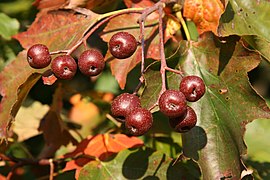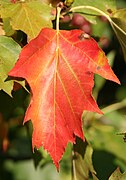Torminalis
| Torminalis glaberrima | |
|---|---|

| |
| Scientific classification | |
| Kingdom: | Plantae |
| Clade: | Tracheophytes |
| Clade: | Angiosperms |
| Clade: | Eudicots |
| Clade: | Rosids |
| Order: | Rosales |
| Family: | Rosaceae |
| Genus: | Torminalis Medik. |
| Species: | T. glaberrima
|
| Binomial name | |
| Torminalis glaberrima (Gand.) Sennikov & Kurtto
| |
| Synonyms[2] | |
|
List (Genus)
(Species)
| |
Torminalis is a genus of plants in the rose family Rosaceae.[2] The genus Torminalis was formerly included within the genus Sorbus, as the section Torminaria, but the simple-leafed species traditionally classified in Sorbus are now considered to form a separate monophyletic group.[3] It is monotypic, being represented by the single species, Torminalis glaberrima, commonly known as wild service tree, chequers, and checker tree.[4] This tree is native to Europe, parts of northern Africa and western Asia.
A possible second species in the genus has been identified through DNA analysis, but a new scientific description for it has not yet been written.[5]
Description
Torminalis glaberrima is a medium-sized deciduous tree growing to 15–25 metres (49–82 feet) tall, with a trunk up to 1.3 m (4+1⁄2 ft) in diameter. The bark is smooth and grayish, but flaky, peeling away in squarish plates to reveal darker brown layers. The leaves are 6–14 centimetres (2–6 inches) long and broad with a 2.5–5 cm (1–2 in) petiole, dark green on both sides, with five to nine acute lobes; the basal pair of lobes are spreading, the rest more forward-pointing and decreasing in size to the leaf apex, and with finely toothed margins; the undersides have small hairs when young, but both sides are smooth and shiny when older; the autumn colour is yellow to red-brown. The flowers are 10–15 millimetres (3⁄8–5⁄8 in) in diameter, with five white petals and 20 creamy-white stamens; they are produced in corymbs 5–12 cm (2–4+1⁄2 in) diameter in late spring to early summer, and are hermaphroditic and insect pollinated. The fruit is a globose to ovoid pome 10–15 mm in diameter, greenish to russet or brown, patterned with small pale lenticel spots when mature in mid to late autumn.[6][7][8]
Taxonomy
- Torminalis glaberrima var. torminalis. Europe, northwest Africa.
- Torminalis glaberrima var. caucasica. Caucasus and Alborz Mountains. Leaves less deeply lobed than in var. torminalis.
The genus Torminalis was formerly included within the genus Sorbus, as the section Torminaria, but the simple-leafed species traditionally classified in Sorbus are now considered to form a separate monophyletic group.[3]
Torminalis glaberrima is a sexually reproducing diploid species that forms diploid and polyploid hybrids with members of the genus Aria (whitebeams).[9] A number of often very localised stable apomictic polyploid species of ultimately hybrid origin between Sorbus torminalis and various species in the genus Aria occur in Europe, including Sorbus latifolia (service tree of Fontainebleau), and S. bristoliensis (Bristol whitebeam).[6] They are now classified as the Karpatiosorbus genus.
Etymology
The tree's Latin name, torminalis means "good for colic".
The name "chequers" may have been derived from the ancient symbol of a pub being the chequer-board (as the fruit were once used to flavour beer)[10] or the spotted pattern of the fruit,[11] though some suggest it comes from the pattern of the bark on old trees.[citation needed]
Distribution and habitat
It is found from Great Britain (England and Wales) east to Denmark and Poland, south to northwest Africa, and southeast to southwest Asia from Asia Minor to the Caucasus and Alborz mountains.[6]
The wild service tree favours deep fertile soils, but can tolerate a wide range of soil conditions, from chalky, superficial, dry soils to temporarily waterlogged soils, often found alongside the true service tree. It can adapt to a variety of climatic conditions, but occurs most often in lowlands. Wild service tree is a light-demanding species, often out-competed by other hardwood species.[12]
It is relatively rare and in Britain is now usually confined to pockets of ancient woodland, although it can also be found growing in hedgerows. It can often be found associated with oak and ash woods, preferring clay and lime based soils. In Britain, summer temperatures are often too low for the seeds to ripen, so its principal method of propagation is by suckers.[6]
Ecology
The fruits are eaten by many birds and a few mammals, making the tree ecologically important.[12]
Uses

The wild service tree is one of the most valuable hardwoods in Europe. The wood is fine-grained, very dense and has good bending strength. It was used in the past to make screws for winepresses, billiard cue sticks, musical instruments and turnery. Today, it is usually only used for decorative veneers.[12]
The fruit, sometimes called "chequers", are edible and taste similar to dates, although they are now rarely collected for food. They are usually too astringent to eat until they are over-ripe and bletted. They were traditionally known as a herbal remedy for colic. Before the introduction of hops, the fruit were used to flavour beer.[10]
Gallery
-
Trunk and leaf canopy
-
Leaves
-
Flowers
-
Foliage and fruit
-
Ripe fruit
-
Autumn leaf colour
References
- ^ Rivers, M.C. & Beech, E. (2017). "Sorbus torminalis". IUCN Red List of Threatened Species. 2017: e.T61957590A112312183. doi:10.2305/IUCN.UK.2017-3.RLTS.T61957590A112312183.en. Retrieved May 31, 2024.
{{cite journal}}: CS1 maint: multiple names: authors list (link) - ^ a b "Torminalis glaberrima (Gand.) Sennikov & Kurtto | Plants of the World Online | Kew Science". Plants of the World Online. Retrieved September 12, 2023.
- ^ a b Lo, E.Y.Y.; Donoghue, M.J. (2012), "Expanded phylogenetic and dating analyses of the apples and their relatives (Pyreae, Rosaceae)", Molecular Phylogenetics and Evolution, 63 (2): 230–243, Bibcode:2012MolPE..63..230L, doi:10.1016/j.ympev.2011.10.005, PMID 22293154
- ^ "Taxon: Sorbus torminalis (L.) Crantz", USDA GRIN Taxonomy, archived from the original on September 18, 2016, retrieved June 30, 2016
- ^
- "Specimen Record GBITS49382-21 (ITS1, 5.8S, ITS2) | Public Data Portal | BOLDSYSTEMS". www.boldsystems.org. Retrieved September 20, 2023.
- "Generic limits of Pyrinae: Insights from nuclear ribosomal DNA sequences". Botanical Studies. 53 (1): 151–164. 2012.
- ^ a b c d e Rushforth, K. (1999). Trees of Britain and Europe. Collins ISBN 0-00-220013-9.
- ^ Mitchell, A. F. (1974). A Field Guide to the Trees of Britain and Northern Europe. Collins ISBN 0-00-212035-6
- ^ Blamey, M. & Grey-Wilson, C. (1989). Flora of Britain and Northern Europe. ISBN 0-340-40170-2
- ^ Pellicer, J.; Clermont, S.; Houston, L.; Rich, T.C.; Fay, M.F. (2012). "Cytotype diversity in the Sorbus complex (Rosaceae) in Britain: sorting out the puzzle". Annals of Botany. 110 (6): 1185–1193. doi:10.1093/aob/mcs185. PMC 3478048. PMID 22922587.
- ^ a b G. J. Monson-Fitzjohn gives three possible origins for chequers as a pub name: the chequer board suggests the passing away of odd hours by a game of "draughts"; others were named from the custom of painting signposts sometimes found outside pubs in alternate black and white squares; and others from the "chequy field" of the coat of arms of a local landowner. 270 hotels, tavern and inns then bore the name.--Monson-Fitzjohn, G. J. (1926) Quaint Signs of Olde Inns. London: Herbert Jenkins (reissued by Senate, London, 1994 ISBN 1-85958-028-9); pp. 34, 45
- ^ Oxford English Dictionary
- ^ a b c Demesure-Muschm, B. & Oddou-Muratorio, S. (2004), Wild service tree - Sorbus torminalis: Technical guidelines for genetic conservation and use (PDF), European Forest Genetic Resources Programme, p. 6, archived from the original (PDF) on January 31, 2017
Further reading
- Wedig Kausch-Blecken von Schmeling: Die Elsbeere. Bovenden 1994, ISBN 3-88452-925-0
- Roper, P. (1993). "The distribution of the Wild Service Tree Sorbus torminalis (L.) Crantz, in the British Isles" (PDF). Watsonia. 19: 209–229. Archived (PDF) from the original on December 23, 2022.
External links
- Wild Service Tree at rhs.org.uk
- Sorbus torminalis - distribution map, genetic conservation units and related resources. European Forest Genetic Resources Programme (EUFORGEN)







